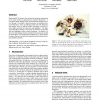Free Online Productivity Tools
i2Speak
i2Symbol
i2OCR
iTex2Img
iWeb2Print
iWeb2Shot
i2Type
iPdf2Split
iPdf2Merge
i2Bopomofo
i2Arabic
i2Style
i2Image
i2PDF
iLatex2Rtf
Sci2ools
SIGGRAPH
1998
ACM
1998
ACM
A Non-photorealistic Lighting Model for Automatic Technical Illustration
Phong-shaded 3D imagery does not provide geometric information of the same richness as human-drawn technical illustrations. A non-photorealistic lighting model is presented that attempts to narrow this gap. The model is based on practice in traditional technical illustration, where the lighting model uses both luminance and changes in hue to indicate surface orientation, reserving extreme lights and darks for edge lines and highlights. The lighting model allows shading to occur only in mid-tones so that edge lines and highlights remain visually prominent. In addition, we show how this lighting model is modified when portraying models of metal objects. These illustration methods give a clearer picture of shape, structure, and material composition than traditional computer graphics methods. CR Categories: I.3.0 [Computer Graphics]: General; I.3.6 [Computer Graphics]: Methodology and Techniques.
| Added | 05 Aug 2010 |
| Updated | 05 Aug 2010 |
| Type | Conference |
| Year | 1998 |
| Where | SIGGRAPH |
| Authors | Amy Gooch, Bruce Gooch, Peter Shirley, Elaine Cohen |
Comments (0)

